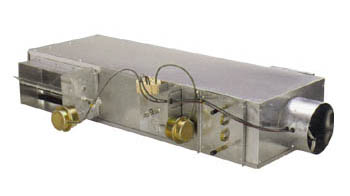|
VAV systems
VAV systems are designed to supply only the volume of conditioned
air to a space that is needed to satisfy the load. Fan energy
is saved when the volume of air handled by the fan is reduced.
Air volume control is accomplished by installing modulating dampers,
or in some cases, an air valve, in the supply duct to each zone.
As the room temperature demand becomes satisfied, the thermostat
signals the damper to move the supply air zone valve toward the
closed position.
When zone valves are throttled, the static pressure in the supply
duct changes. A static pressure sensor located in the supply duct
senses the static pressure change, and either increases or decreases
the airflow from the source, using variable speed control or dampers
on the main air supply fan.
A key component in the VAV system is the air valve. It is commonly
installed inside an insulated sheet metal box suspended in a ceiling
plenum. The air valve has a damper that regulates the air flow
in response to the room's thermostat. A multi-port pressure sensing
ring provides both accurate airflow sensing and control in response
to duct static pressure.
As VAV systems have evolved, so have the terminals. There are
six popular VAV systems. They are:
Shutoff
VAV Reheat
Parallel Fan Powered
Series Fan Powered
Dual Duct
Changeover/Bypass
There are many different types of vav units:
|
 |
Single Duct
Dual Duct
Reheat
Fan Powered
Series Fan
VAV boxes can also be classified as pressure independent and pressure
dependent. A pressure independent VAV measures cfm and will maintain
the proper airflow regardless of the box inlet static pressure
provided by the main air handling unit. A pressure dependent VAV
does not measure airflow. The cfm will change depending on the
inlet static pressure. VAV systems are also usually designed with
a diversity factor which means that the main air handler design
airflow is less than the sum of the total airflow of all the VAV's.
This is a common design because not all of the VAV's in a building
will be in full cooling or maximum cfm all at once. There are
three ways that a VAV can be controlled; pheumatic, electric,
or Automated Control Systems (ACS). Pneumatic control systems
are becoming obsolete. The VAV damper is opened and closed by
a controller sending air pressure to an actuator hooked to the
VAV damper. Electric simply sends a signal from the thermostat
in volts to an electric motor connected to the VAV damper. ACS
works the same as electric except there is a main computer set
up in the building that gets information from all the VAV's and
air handlers displaying it in text and graphics form. The possibilities
are endless with automated controls and is truly a huge leap forward
in the HVAC industry.
|

